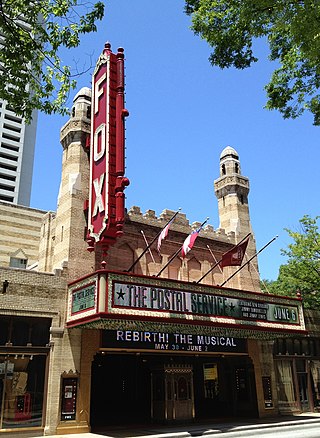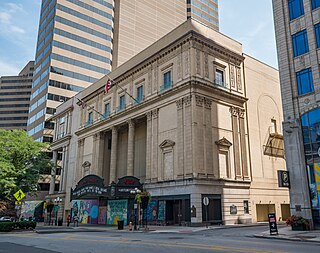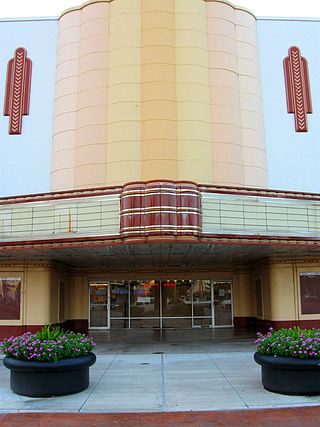
Lucy the Elephant is a six-story elephant-shaped example of novelty architecture, constructed of wood and clad in tin in 1882 by James V. Lafferty in Margate City, New Jersey, approximately five miles (8 km) south of Atlantic City. Originally named Elephant Bazaar, Lucy was built to promote real estate sales and attract tourists. Today, Lucy is the oldest surviving roadside tourist attraction in America.

The New York City Landmarks Preservation Commission (LPC) is the New York City agency charged with administering the city's Landmarks Preservation Law. The LPC is responsible for protecting New York City's architecturally, historically, and culturally significant buildings and sites by granting them landmark or historic district status, and regulating them after designation. It is the largest municipal preservation agency in the nation. As of July 1, 2020, the LPC has designated more than 37,800 landmark properties in all five boroughs. Most of these are concentrated in historic districts, although there are over a thousand individual landmarks, as well as numerous interior and scenic landmarks.

Rogers Park is the first of Chicago's 77 community areas. Located 9 miles (14 km) from the Loop, it is on the city's far north side on the shore of Lake Michigan. The neighborhood is culturally diverse with a progressive mindset, featuring lush green public spaces, early 20th century architecture, live theater, unique bars/restaurants, and beaches. It is bounded by the city of Evanston along Juneway Terrace and Howard Street to the north, Ridge Boulevard to the west, Devon Avenue and the Edgewater neighborhood to the south, and Lake Michigan to the east. The neighborhood just to the west, West Ridge, was part of Rogers Park until the 1890s and is still commonly referred to as West Rogers Park.

The Frederick C. Robie House is a U.S. National Historic Landmark now on the campus of the University of Chicago in the South Side neighborhood of Hyde Park in Chicago, Illinois. Built between 1909 and 1910, the building was designed as a single family home by architect Frank Lloyd Wright. It is considered perhaps the finest example of Prairie School, the first architectural style considered uniquely American.

William Louis Veeck Jr., also known as "Sport Shirt Bill" and "Wild Bill", was an American Major League Baseball franchise owner and promoter. Veeck was at various times the owner of the Cleveland Indians, the St. Louis Browns, and the Chicago White Sox. As owner and team president of the Indians in 1947, Veeck signed Larry Doby, thus beginning the integration of the American League, and the following year won a World Series title.

The Kunsthaus Tacheles was an art center in Berlin, Germany, a large building and sculpture park on Oranienburger Straße, in the sub-neighborhood of Spandauer Vorstadt in the Mitte district. Huge, colorful graffiti-style murals were painted on the exterior walls, and modern art sculptures were featured inside. The building housed an artist collective from 1990 until 2012.

The Fox Theatre, a former movie palace, is a performing arts venue located at 660 Peachtree Street NE in Midtown Atlanta, Georgia, and is the centerpiece of the Fox Theatre Historic District.

The Wainwright Building is a 10-story, 41 m (135 ft) terra cotta office building at 709 Chestnut Street in downtown St. Louis, Missouri. The Wainwright Building is considered to be one of the first aesthetically fully expressed early skyscrapers. It was designed by Dankmar Adler and Louis Sullivan and built between 1890 and 1891. It was named for local brewer, building contractor, and financier Ellis Wainwright.

The Sunshine Building is a historic six-story building in downtown Albuquerque, New Mexico. It was built in 1924 by local theater owner Joseph Barnett and houses the Sunshine Theater as well as commercial space and offices. The Sunshine operated primarily as a movie theater until the 1980s, though it was also equipped for Vaudeville shows and other live performances. Since 1990 it has operated as a live music venue, hosting many notable acts. The building was listed on the New Mexico State Register of Cultural Properties in 1985 and is also an Albuquerque City Landmark.

The Ohio Theatre is a performing arts center and former movie palace on Capitol Square in Downtown Columbus, Ohio. Known as the "Official Theatre of the State of Ohio", the 1928 building was saved from demolition in 1969 and was later completely restored. The theater was declared a National Historic Landmark in 1977 as one of the nation's finest surviving grand theaters.

The Reliance Building is a skyscraper located at 1 W. Washington Street in the Loop community area of Chicago, Illinois. The first floor and basement were designed by John Root of the Burnham and Root architectural firm in 1890, with the rest of the building completed by Charles B. Atwood in 1895. It is the first skyscraper to have large plate glass windows make up the majority of its surface area, foreshadowing a design feature that would become dominant in the 20th century.

Randall Park Mall was a shopping mall located in the village of North Randall, Ohio, United States. It opened on August 11, 1976 on the site of what used to be the Randall Park Race Track. After over a decade of decline, it closed on March 12, 2009. The former Dillard's store and interior of the mall were demolished in 2015 to make way for an industrial park, and the remaining anchor tenants were demolished in 2017 after they all closed down. Amazon built a new distribution center on the site in 2018.

The Emil Bach House is a Prairie style house in the Rogers Park neighborhood of Chicago, Illinois, United States that was designed by architect Frank Lloyd Wright. The house was built in 1915 for an admirer of Wright's work, Emil Bach, the co-owner of the Bach Brick Company. The house is representative of Wright's late Prairie style and is an expression of his creativity from a period just before his work shifted stylistic focus. The Bach House was declared a Chicago Landmark on September 28, 1977, and was added to the U.S. National Register of Historic Places on January 23, 1979.

St. Paul's historic Landmark Center, completed in 1902, originally served as the United States Post Office, Courthouse, and Custom House for the state of Minnesota. It was designed by Willoughby J. Edbrooke, who served as Supervising Architect of the U.S. Treasury Department in 1891–92. Edbrooke designed a body of public architecture, much of which, like this structure, was completed after his 1896 death. Landmark Center stands at 75 West Fifth Street in Rice Park and is now an arts and culture center.

The Copernicus Center is a 1,852-seat former movie palace that is now part of the Copernicus Center in the Jefferson Park community area of Chicago in Cook County, Illinois, United States. The Copernicus Center is located at 5216 W. Lawrence Avenue.

Golden Gate Theater is a California Churrigueresque-style movie palace built in 1927 on Whittier Boulevard in East Los Angeles, California. In 1982, it was listed on the National Register of Historic Places. The theater closed in 1986; the retail building built around it was damaged in the 1987 Whittier Narrows earthquake and demolished in 1992. The remaining theater building was left vacant for more than 20 years as preservationists fought with owners and developers over the future of the building. It was finally converted into a drugstore and reopened in 2012.

The Alabama Theatre is a historic movie theater located at the intersection of Alabama Street and Shepherd Drive in the Upper Kirby district of Houston, Texas. Constructed in 1939, in the Art Deco and Streamline Moderne styles as a suburban theater, the Alabama primarily booked roadshow engagements through most of its history. Today, the theater is home to a Trader Joe's grocery store. It is one of the buildings of the Alabama Shepherd Shopping Center, owned by Weingarten Realty.

The Davis Theater, originally known as the Pershing Theater, is a first run movie theater located in the Lincoln Square neighborhood of Chicago. Built in 1918, the theater has operated in different capacities in its history, showing silent films, German-language films, and various forms of stage performance. In 1999, the Davis was planned to be demolished to build residential condos, but the plans were cancelled in part due to a negative response from the community. It is one of the few operating neighborhood movie theaters in Chicago. Its building was listed on the National Register of Historic Places in 2016.

The Terrace Theatre was located at 3508 France Avenue North in Robbinsdale, Minnesota. Upon its opening on May 23, 1951, the Terrace received critical acclaim for its “bold architectural lines [and] extensive patron services.” The 1,299-seat theater, designed in the mid-century modern style by the Minneapolis architectural firm of Liebenberg & Kaplan (L&K) for movie exhibitors Sidney and William Volk, was a popular Twin Cities destination for nearly fifty years. It changed hands in 1980 and again in 1987, when it was remodeled from a single-screen auditorium into three screens by dividing the balcony. The last movie was screened in 1999 and the theater remained boarded up for seventeen years before it was demolished in the fall of 2016 to be replaced by a Hy-Vee grocery store.

Lockridge Medical Clinic was a historic building notable for its Prairie School-style design by Frank Lloyd Wright, located in Whitefish, Montana, United States. Originally built as a medical clinic in 1963, the building served a variety of other commercial purposes before it was demolished by its owners in 2018.



















